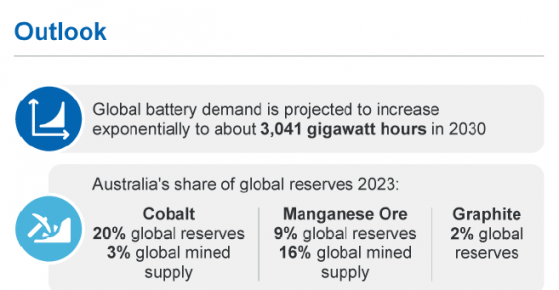Australia, the world's largest lithium producer and the third-largest cobalt producer, is in a prime position to support the increasing global demand for battery metals, according to a recent report by Australia's Office of the Chief Economist (OCE).
As international buyers seek to diversify their supply chains away from China, the country is well-positioned to advance its role in the production of these key minerals.
The abundance of battery metals, including manganese, graphite, cobalt, lithium and nickel, combined with Australia's expertise in resources technology and processing innovation, positions the Australian industry for success, according to OCE
Furthermore, the United States is considering including Australia for tax credits under its Inflation Reduction Act, further solidifying Australia's position in this sector.
Global demand.
Abundance of battery metals
The OCE's latest Resources and Energy Quarterly (REQ) report reveals that Australia boasts the largest nickel resource and the second-largest lithium and cobalt resource among all nations.
The growing demand for battery technologies, particularly in electric vehicles (EVs) and energy storage systems, driven by the global push for achieving net-zero emissions by 2050, further supports Australia's potential in this domain.
Global battery market.
Lithium – key component
Lithium, a key component of battery technologies, is expected to experience continued growth in Australian mine production due to the country's leading position in lithium extraction globally.
The OCE forecasts a 9.7% increase in spodumene production to 3.4 million tonnes in 2023-24, followed by a 29% increase to 4 million tonnes in 2024-25.
Despite this positive outlook, the OCE predicts that the average spot prices for lithium will increase to $4,357 per tonne this year, only to decline to $2,740 per tonne in 2024 and further to $2,149 per tonne by 2025, as supply catches up with demand.
Consequently, Australia's export earnings from lithium are expected to decrease, according to the REQ report.
Nickel – to contribute to economic growth
Nickel, another important battery mineral, is anticipated to contribute to Australia's economic growth.
The REQ report estimates a 3.9% increase in nickel export earnings to A$4.5 billion in 2022-23, driven by strong nickel prices.
However, despite a forecasted increase in production and export volumes, earnings are expected to decline to A$4.4 billion in 2023-24 and A$4.2 billion in 2024-25, primarily due to lower prices during that period.
Cobalt – significant potential.
Australia holds an estimated 20% of global cobalt resources but currently lacks dedicated cobalt mines in operation, as per the OCE's findings.
Nevertheless, the report highlights significant potential for Australia to increase its cobalt supply to meet the rising demand for EV batteries.
Cobalt deposits in Australia are typically found as by-products of copper, gold, or nickel mining operations, with the majority located in Western Australia.
Manganese – flat overall
Manganese, on the other hand, has seen a decrease in Australia's ore reserves from 135 million tonnes in 2021 to 120 million tonnes in 2022.
The REQ report suggests that future manganese production will remain relatively flat overall over the next decade.
Graphite – limited reserves
Australia possesses relatively limited reserves of graphite, with no active graphite mines currently in operation.
South Australia leads the way, hosting 65% of Australia's economically proven graphite resources, while Western Australia accounts for 18% and Queensland for 17%.
Several projects aimed at advancing graphite production are underway, as outlined in the Resources and Energy Major Projects 2022 report.
Geoscience Australia rates the country's geological potential for graphite as moderate.
Read more on Proactive Investors AU
